

Patterns. Knitting. CROCHET : apprendre à crocheter. When row gauge matters. So, you know what’s really fun to talk about?

Gauge. Gauge, gauge, gauge. Super awesome, right? Well, okay, sometimes it’s not. Sometimes it is the opposite of fun, let’s be honest, but it’s the reference point that defines so much of what we do in knitting. We’ve talked about swatches before around here. (For example, if we are aiming for a stitch gauge of 5 sts/inch in stockinette stitch, and the intended bust circumference of the sweater is 40 ins, then we would expect a stockinette pullover would have about 200 sts. A lot of the time, once we’ve achieved a stitch gauge that works for the pattern, we can easily stop there and not bother as closely with row gauge (vertical gauge – number of knitted rows per inch). However, there are some instances when row gauge does matter. 1. Whether or not this is a good or bad result is up to you to decide, relative to how well you think those raglan depths will fit you. 2. 3. 4. 5.
Have a great Wednesday! Like this: Like Loading... Tricot. Tricot. A Stretchier Bind-Off. I showed you a really great cast-on for toe-up socks on Monday...but what do you do when you get to the cuff and need to bind off?

Lots of folks, myself included, get a little tight-fisted when it comes to binding off, and it's a bit demoralizing to knit a beautiful sock that fits you perfectly... that is, it would fit you perfectly if you could get the cuff edge on over your heel! There are a couple of bind-offs you can use to loosen things up a bit. One of them, the sewn bind-off, is described in Gila Shoshany's Beyond the Basics in the new Fall Knits. (You can sign up to become a subscriber here.)
Today, I thought I'd show you another one of my favorite flexible bind-offs, one that I've used for neck edges, sleeve edges, and even sock cuffs. Simple Ring Beginning for Circular Shawls. I was so taken by Jane's Lyra (actually Neibling's Lyra, but Jane alerted me to the pattern's existence, so she gets my credit), that I dug out the magazine and some black Zephyr to swatch it.
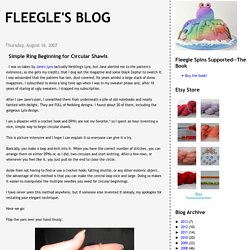
I was astounded that the pattern has lain, dust-covered, for years amidst a large stack of Anna magazines. I subscribed to Anna a long time ago when I was in my sweater phase and, after 10 years of staring at ugly sweaters, I stopped my subscription. CraftyCupcake's The Oyster that Wrecked the Ship. Emily Ocker's Circular Cast On. This is a pictorial representation of Emily Ocker's Cast On, used to start a piece of circular knitting (like a tablecloth, shawl or dishcloth) in the middle.
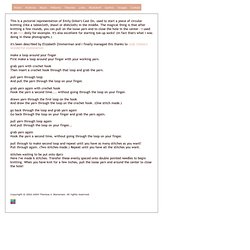
The magical thing is that after knitting a few rounds, you can pull on the loose yarn end to close the hole in the center - I used it on this doily for example. It's also excellent for starting toe-up socks! (In fact that's what I was doing in these photographs.) It's been described by Elizabeth Zimmerman and I finally managed this thanks to Judy Gibson's wonderful explanation. First make a loop around your finger with your working yarn. Then insert a crochet hook through that loop and grab the yarn. And pull the yarn through the loop on your finger. Hook the yarn a second time.... without going through the loop on your finger. And draw the yarn through the loop on the crochet hook. Go back through the loop on your finger and grab the yarn again. And pull through the loop on your finger... Pull through again. Here I've made 6 stitches. Binding Off Lace. I have finished all the knitting on the Arctic Diamonds Stole.

See, here's the end of the last diamond and the final edging. It's still on the needles, because I haven't yet figured out how to bind it off. The bind-off isn't a huge deal for this stole; the edge needs only to be about as sideways stretchy as the body. But, since I intend to knit more -- and increasingly difficult -- lace projects, it seemed reasonable to investigate a few different methods of getting a super-loose finish. I settled on three to swatch, and the results were most interesting. The first is called Modified Standard by Eunny Jang (Interweave Knits, Fall 2006), and it's the least stretchy of the three. Editorial spring 06. At the very basic there are three types of spindle: top whorl, bottom whorl and supported.
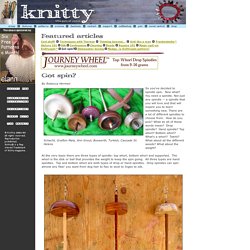
The whorl is the disk or ball that provides the weight to keep the spin going. All three types are hand spindles. Top and bottom whorl are both types of drop or hand spindles. How do you make a good looking 2-ply yarn? Kate from Massachusetts asked, "Could you please do a blog entry on how to ply a 2-ply yarn that comes out well?
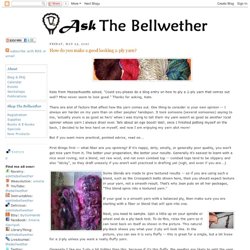
Mine never seem to look good. " Thanks for asking, Kate. There are alot of factors that affect how the yarn comes out. How fine do I spin my singles to get a target WPI in my plied yarn? How do you determine singles WPI based on how many plies you want?

Well, that is in part a function of twist angle or grist, so all I can give you are my ball parks. I tend to spin woolen, for an airy yarn, but will spin high-twist sock yarns. More on twist angle (and yards per pound) in a little bit. Plying - how do you keep the singles from un-twisting while you wind and ply? - Forums - Spinning Daily. How To Dye Wool Roving. Preface: I just want to briefly preface these directions by saying that this is the method I use at Wind Rose.
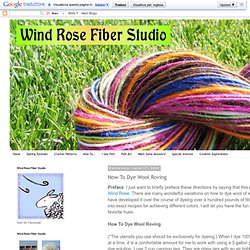
There are many wonderful variations on how to dye wool of which this is just one. I have developed it over the course of dyeing over a hundred pounds of fiber. I have not gotten into exact recipes for achieving different colors. I will let you have the fun of creating your own favorite hues. How To Dye Wool Roving (*The utensils you use should be exclusively for dyeing.) Spinning Handpainted Rovings.